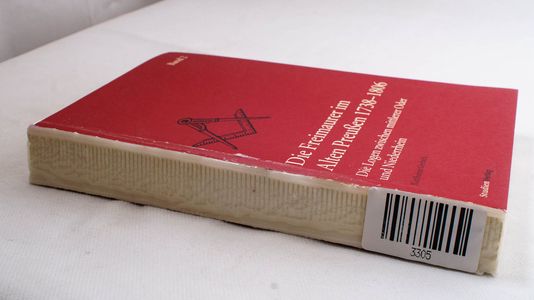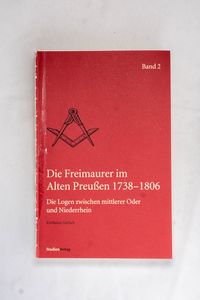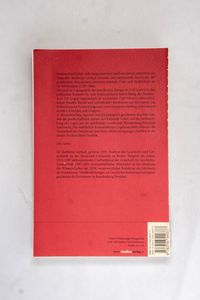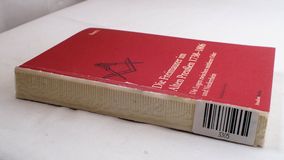
Die Freimaurer im Alten Preußen 1738-1806 - Karlheinz Gerlach
Netto: 64.48 €68,99€
inkl. MwSt. zzgl. Versand
Bearbeitungszeit: 3 Werktage
Sofort lieferbar (auf Lager)
1x Stück verfügbar
Buchzusammenfassung:
In the centre of the present research on the social history of the Prussian freemasonry in the 18 century are the history of the lodges, the membership and its structure, the social and cultural life of the lodges and their influence on society, i.e. the actual societal situation of the lodges in the late feudal society of Brandenburg-Prussia towards the end of the Early Modern Age. The ideological aims and practice of the systems of freemasonry (rituals etc.), the philosophical and literary critique as well as the arts rooted in freemasonry are delt with only in passing. The sources of this research are the traditional manuscripts from archives, mostly unique old scripts and modern masonic literature, as well as the literature of socio-historical, regional-historical and biographical origin. The following sources have been searched and analyzed: the opulent masonic sources of the ancient Prussian lodges of the Geheimes Staatsarchiv Preußischer Kulturbesitz, Berlin-Dahlem, having been made available since 1990 the sources of the Orde van vrijmetselaren onder het Grootoosten der Nederlanden, Den Haag, of the Den danske Frimurerorden, Kopenhagen, of the Landesarchiv Berlin, of the Landesarchiv Magdeburg - Landeshauptarchiv, the Brandenburgisches Landeshauptarchiv, Potsdam, the Stadtarchiv Potsdam, the Thüringisches Hauptstaatsarchiv, Weimar, the Österreichisches Staatsarchiv, department Haus-, Hof- und Staatsarchiv, Vienna, as well as the libraries of the Deutsches Freimaurer-Museum, Bayreuth, the Great Lodge of Freemasons of Germany, Berlin, the Great National Mother Lodge To the Three Globes in Berlin, the Biblioteka uniwersytecka w Poznaniu, Pracownia Zbiorów Masonskich, Poznan, and the Great Lodge of the Old Free and Accepted Freemasons of Austria, Vienna. The Handbook is structured chronologically according to regions and with analogue topics the alphabetic commented lists of the entire membership follow the chapters of every lodge. Regionally the research covers the Prussian states within their borders of 1795 (Peace of Basel, Third Polish Partition), but without territories that followed a relative autonomous way in their history, or belonged to Prussia only a short term, or came to Prussia after 1795. This manuscript deals with Prussian lodges between the Oder river and the Lower Rhine the envisaged volumes for publication will include Berlin, Pomerania, Eastern and Western Prussia as well as Silesia. The favourable policy of the Prussian kings formed the external political basis for a continuous development of the freemasonry in the monarchy. This began 1740 with the legitimation of the freemasons by Frederic II and led to the Common Law of the Prussian States and the following Edict on Secret Associations in 1798. Between 1739 and 1806, 47 legally constituated Johannis lodges as parts of the larger Lodges have been registered in 30 towns in the middle and western provinces, but without Berlin. Until the Seven Year War (1756-1763) the small number of isolated lodges was restricted to the larger cities. A stimulating influence for the freemasonry came only from the garnisons (lodges of the captured officers). After the war, during a long peaceful period, the freemasonry took a steep upsurge, despite the internal struggles, called the Lodge Wars, and the splittings. The freemasonry extended over the entire country, to the big cities and medium-sized towns and many rural towns. The Lodges distinguished themselves from other associations by their social openness and broadth of membership. They organized a rising number of men from different classes, social strata, groups or trades, (christian) confessions, education and ages. The freemasons belonged to the newly emerging social strata and groups which formed the Prussian state of Frederic II and were closely connected with its progress. These were the nobility and the middle class, the clerks and officers, bankers and manufacturers, intellectuals and artists. The.
FAQ zum Buch
Die Loge “Du Roi“ wurde 1739 in Rheinsberg durch den Kronprinzen Friedrich, den Hamburger Meister Georg Ludwig v. Oberg und Jakob Friedrich Bielfeld gegründet. Sie zählte zu den ersten Freimaurerlogen in Brandenburg-Preußen und umfasste engste Vertraute des Königs, darunter Adelige, Offiziere und Intellektuelle. Die Versammlungen fanden zunächst im Schloss Rheinsberg statt, später auch in Charlottenburg. Die letzte Zusammenkunft der Loge wird auf Oktober 1740 datiert. Dieses FAQ wurde mit KI erstellt, basierend auf der Quelle: S. 23, ISBN 9783706540377
Die Loge Diamant wurde 1763 in Potsdam gegründet und bestand aus adligen Gardeoffizieren. 1768 entstand die Loge Minerva, ebenfalls in Potsdam, als Nachfolgerin der Diamant. Beide Logen gehörten zur Strikten Observanz und zählten bekannte Persönlichkeiten wie Johann Wilhelm Kellner v. Zinnendorf und Levin v. Geusau zu ihren Mitgliedern. Dieses FAQ wurde mit KI erstellt, basierend auf der Quelle: S. 29, ISBN 9783706540377
Die Sozialstruktur der Loge Zur goldenen Krone in Stendal war geprägt von einer Mehrheit bürgerlicher Mitglieder (74,3 Prozent) und einer kleineren Gruppe niederen Adels (25,6 Prozent). Beamte dominierten mit 51,3 Prozent der Mitglieder, während Offiziere 19,3 Prozent ausmachten. Andere soziale Gruppen wie Kaufleute, Theologen oder Ärzte bildeten Minderheiten. Der Anteil der Adligen schwankte über die Zeit, etwa von 37,5 Prozent im Jahr 1780 auf 12,3 Prozent im Jahr 1801. Dieses FAQ wurde mit KI erstellt, basierend auf der Quelle: S. 101, ISBN 9783706540377
Die Loge Zum aufrichtigen Herzen in Frankfurt (Oder) wurde in den frühen 1740er Jahren gegründet und hatte ihre erste bekannte Versammlung am 15. November 1741 während der Herbstmesse. Sie wurde von Mitgliedern der Berliner Loge Aux trois globes initiiert, darunter Frédéric Alexandre Fromery und Christian Gregory, die als Mêtre, Surveillants und andere Ämter fungierten. Die Loge förderte den Frankfurter Kaufmann Franz Heinrich Matthias zum Meister und nahm den Dresdner Kaufmann Christian Moritz Kimmel sowie einen Frankfurter Studenten auf. Dieses FAQ wurde mit KI erstellt, basierend auf der Quelle: S. 130, ISBN 9783706540377
Die Logen in Halle (Saale) umfassten die Afrikanische Bauherrenloge, die Winkelloge des alten Pinckow und die Loge Zu den drei Degen. Die Texte erwähnen keine direkte Rolle dieser Logen in der Deutschen Union. Die historischen Aufzeichnungen sind lückenhaft und konzentrieren sich auf die Archivverluste und Mitglieder der Logen. Die Verbindung zur Deutschen Union wird im Text nicht explizit hergestellt. Dieses FAQ wurde mit KI erstellt, basierend auf der Quelle: S. 349, ISBN 9783706540377
In der Logendemokratie der Brandenburger (Havel) Loge war die innere Demokratie während der Strikten Observanz stark eingeschränkt. Nach der Wiedereröffnung 1801/02 wurde ein reformiertes Wahlverfahren angewandt, bei dem Beamte durch Stimmenmehrheit gewählt wurden. Der Meister vom Stuhl und der deputierte Meister wurden durch Abstimmung bestimmt. Dieses FAQ wurde mit KI erstellt, basierend auf der Quelle: S. 201, ISBN 9783706540377






